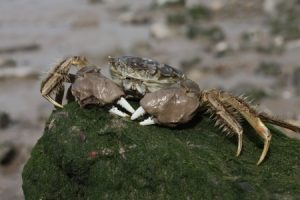The Chinese mitten crab (Eriocheir sinensis) is not a delicacy that immediately springs to mind in the Western world but having eaten them whole in a battered form its surprising they are not better known. It is known as the mitten crab because its claws are coated with small clumps of dark brown fur.

The crab itself is relatively soft shelled which makes it ideal as a culinary delicacy especially in the months before Christmas where it is hailed in Shanghai and Eastern China generally. The crab meat is claimed by the Chinese to have a cooling influence, a ‘yin’ effect on the body. Crabs collected from certain locations are prized above others. For example, one caught from the Yangcheng lake is valued above all others although Chongming has its supporters.
To eat them means an orgy of pulling off legs and cracking shells, plenty of messy fingers and shards of chitin everywhere. Nonetheless, the flavour is a gourmet’s delight. It is possible to avoid the carnage by having the crabmeat ready prepared although the theatre is lost. The legs can be stir-fried with asparagus.
Only recently, the sensory profiling of the mitten crab was reported (Wang et al., 2016). The taste and aroma profiles of three types of mitten crab was described and the equivalent umami concentration (EUC) characterised. It appears the nucleotide concentrations in the ovaries of the female produced the strongest umami flavour. This particular characteristic is a measure of their quality and so their price. Analytical measures were made using the E-tongue and E-nose. The total free amino acid contents of wild caught crabs were at their highest level in meat, gonads and the liver. Nine volatile compounds were also identified. It may be the case that those from Yangcheng lake were the best quality in flavour because the umami producing amino-acids were found in the crab muscle.
The crab can survive relatively polluted waters which suggests that careful management of the feedstock is necessary to avoid unexpected poisoning of the waters and making the crab unpalatable.
Invasion
One undesirable issue associated with them is their presence in British freshwater where they are a major invasive species. They were originally brought over in the ballast tanks of shipping and have now settled in a number of estuaries along the Eastern coast and in many river outflows of Europe. At least they might serve as a source of convenient food. The damage they cause to river banks by their burrowing and the fact that they enjoy eating salmon roe and preying on crayfish makes them an ecological enemy.
References
Wang, S., He, Y., Wang, Y., Tao, N. Wu, X., Wang, X. (2016) Comparison of flavour qualities of three sourced Eriocheir sinensis. Food Chem., 200 pp. 1-16

Leave a Reply